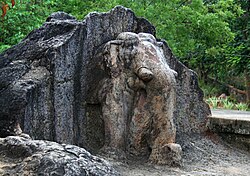From Bharatpedia, an open encyclopedia
Thank you for being part of the Bharatpedia family! click here to donate.
transparency: ₹0 raised out of ₹100,000 (0 supporter)
Shanti Stupa (Peace Pagoda) at Dhauligiri
Dhauli is located on the banks of the river Daya , 8 km south of Bhubaneswar in Odisha , India .
Dhauli hill is presumed to be the area where the Kalinga War was fought.[1]
Imagary
Picture of Dhauli Light and Sound Show
Light and sound show in Dhaulagiri
Sleeping Buddha statue at Dhauli Shanti Stupa
Lion Sculpture at the entrance of Dhauli Shanti Stupa
References External links Coordinates : 20°11′32.54″N 85°50′22.16″E / 20.1923722°N 85.8394889°E / 20.1923722; 85.8394889
Edicts of Ashoka (Ruled 269–232 BCE)
Regnal yearsAshoka
Type of Edict
Geographical location
Year 8
End of the Kalinga war and conversion to the "Dharma "
Year 10[1]
Minor Rock Edicts Related events: Bodhi tree in Bodh Gaya Mahabodhi Temple and Diamond throne in Bodh GayaSangha Third Buddhist Council Sohgaura inscription Pillars of Ashoka
Kandahar Bilingual Rock Inscription (in Greek and Aramaic , Kandahar )
Minor Rock Edicts in Aramaic :Laghman Inscription , Taxila inscription
Year 11 and later
Minor Rock Edicts (n°1, n°2 and n°3) (Panguraria , Maski , Palkigundu and Gavimath , Bahapur/Srinivaspuri , Bairat , Ahraura , Gujarra , Sasaram , Rajula Mandagiri , Yerragudi , Udegolam , Nittur , Brahmagiri , Siddapur , Jatinga-Rameshwara )
Year 12 and later[1]
Barabar Caves inscriptions Major Rock Edicts
Minor Pillar Edicts Major Rock Edicts in Greek: Edicts n°12-13 (Kandahar )Edicts No.1 ~ No.14 (in Kharoshthi script: Shahbazgarhi , Mansehra Edicts (in Brahmi script : Kalsi , Girnar , Sopara , Sannati , Yerragudi , Delhi Edicts ) Separate Edicts 1&2 :(Dhauli , Jaugada )
Schism Edict , Queen's Edict (Sarnath Sanchi Allahabad ) Lumbini inscription , Nigali Sagar inscription
Year 26, 27[1]
Major Pillar Edicts
In Indian language:Major Pillar Edicts No.1 ~ No.7 (Allahabad pillar Delhi pillar Topra Kalan Rampurva Lauria Nandangarh Lauriya-Araraj Amaravati ) Derived inscriptions in Aramaic , on rock:Kandahar, Edict No.7 [2] [3] Pul-i-Darunteh, Edict No.5 or No.7 [4]
↑ 1.0 1.1 1.2 Yailenko,Les maximes delphiques d'Aï Khanoum et la formation de la doctrine du dhamma d'Asoka, 1990, p. 243 .
↑ Inscriptions of Asoka de D.C. Sircar p. 30
↑ Handbuch der Orientalistik de Kurt A. Behrendt p. 39
↑ Handbuch der Orientalistik de Kurt A. Behrendt p. 39








